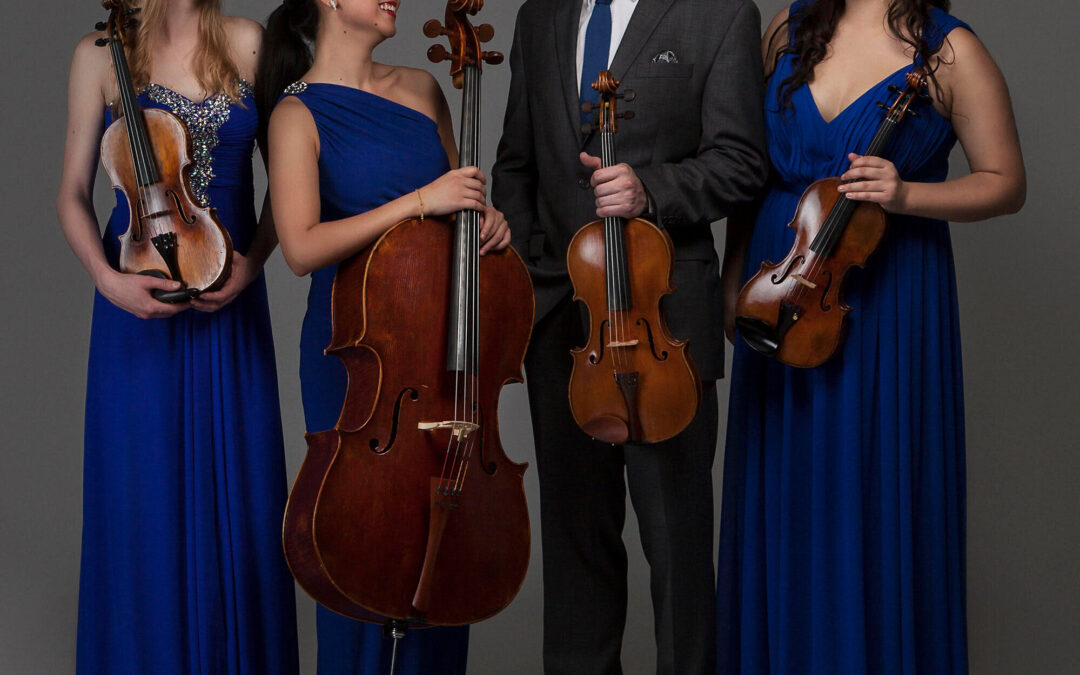By Montague Gammon III
The Ulysses Quartet’s December 4 concert brings to Chrysler Museum’s intimate Kaufmann Theater a deliberately eclectic mix of chamber pieces from as long ago as the 1790s and as recently as 2017.
It begins with the “lively… full of sprit and humor” 1797-98 Quartet Op. 76, #5, in D Major, by chamber quartet pioneer “Papa” Joseph Haydn, and comes to a rousing close with a “virtuosic horse race” of a Beethoven finale that packs “the most fun possible in the smallest amount of time.” That concert closing work is 35-36 year old Ludwig’s “Razumovsky” Quartet No. 9, in C major op. 59, #3 (1806).
Those quotations are from a phone chat with Ulysses’ Second Violin Rhiannon Banerdt, who referred to the concert as “the tale of two Rhiannons,” because the 2017 work, third on the program, is an instrumental arrangement of singer songwriter Rhiannon Giddens’ haunting first person narrative of a slave mother’s plaint, “At the Purchaser’s Option.”
Benjamin Britten’s Quartet No. 2, in C major, which has been on this group’s “bucket list for years,” slots in between Haydn and Giddens. Banerdt calls the Britten a “‘Wow, that was an experience!” piece to hear.
This is the Feldman Chamber Music Society’s third of six, 2023–24, Monday evening concerts.
Quartet founding member and CUNY faculty member and doctoral candidate Banerdt, who made her solo professional musical debut at the age of 14, will be joined by two other Ulysses founders and violist.
Christina Bouey (also a coloratura soprano and composer) is First Violin; she played Carnegie Hall last year, and has a debut solo album to her name. Cellist Grace Ho, properly Doctor of Musical Arts Ho (Manhattan School of Music), has also been part ot the Ulysses Quartet since its founding in 2015.
Violist Aria Cheregosha brings to the Ulysses Quartet performing experience at Carnegie Hall and the Kennedy Center, garnered by the time she was 13. She is an Artist in Residence for 2023-2024 at the Harvard Research Institute, Dumbarton Oaks.
The Feldman “program is centered around the first thing that we wanted to do…the Britten,” Banerdt said. “it’s under half an hour, but it’s just this monumental piece from the first half the 20th century, an amazing period of experimentation and of this feeling that anything was possible with music.” And as she said, a work that will wow the listener.
It has a vigorous first moment, which seems more forceful than usually found in traditional chamber music. The second movement begins rather like a conventional, older chamber piece on some kind of mind altering substance, then turning so lively that it could be used to accompany a film’s car chase. The third begins with a somber, rather foreboding, even xlightly eerie feeling, almost like horror film music raised to some high power and then squared again. Then there’s a bit of lyricism (it perhaps could be a great ballet score), then it’s languorous, even yearning, finally ending in a way that proclaims, “And .. So … THERE!”
Haydn’s Quartet is, Banerdt, said, “one of the first pieces we learned and recorded…This piece has everything…[There is] something so lively I find in his music, full of sprit and humor…extremely elegant and funny in a tongue in cheek, sophisticated way, and just very, very beautiful.”
Just the first few bars of the Haydn, even to a non-musician, reveal a master’s hand.. (“Perfect craftsmanship,” agrees Banerdt.) The first movement hints of gleefulness, followed by a soulful, sonorous, contemplative passage. The third movement: playfulness, themes tossed back and forth, the cello coming to the fore with a hint of something ominous being won over into a dance with lighthearted companions. The fourth movement is a hell-for-leather race of virtuosity.
Giddens’ piece is part of Ulysses Quartet’s determination to “keep variety in our programs so there are different things for people to chew on and for different tastes. We do try to have…a woman composer on the program to keep it in peoples’ minds that it happens and for them to hear what hasn’t been played that much. [The performance will have a] little intro explaining the subject matter of the song which is really quite heavy, but the music…has a real weight to it in and of itself.”
Then comes ”the meaty, dramatic, personal, very virtuosic” Beethoven, which starts off with one of those typically Beethoven-esque listen-up-right-now commanding opening chords.
The four movements go from a somber beginning through a slightly ethereal passage and then off we go, into quick paced, feel-good chamber conversations. Lyrical stuff turns energetic, becomes less forceful, and finally there’s a full throttle, breath taking, tachycardia inducing run, a quick breath and that “really virtuosic horse race” to the finish line.
Banerdt’s childhood, she says, is why “Seeking out different kinds of music [comes] naturally to [her].” Her older siblings took music lessons, and her parents “had records from Frank Zappa and Captain Beefheart [who makes Zappa seem mainstream] and the Beatles and the Doors to Yo Yo Ma and ‘Switched on Bach.’ ”
“What we value as a quartet…we like a lot of different kinds of music…is finding music that we really connect to personally…and getting that to people of all backgrounds and all tastes.”
“The wonderful thing about music is that every time you hear it, it’s unique. This music is for you, regardless of your experience.”
WANT TO GO?
Ulysses Quartet
Presented by Feldman Chamber Music Society
Chrysler Museum of Art Kaufman Theatre
One Memorial Place, Norfolk
7:30 p.m., Monday, Dec.4
757-552-1630




